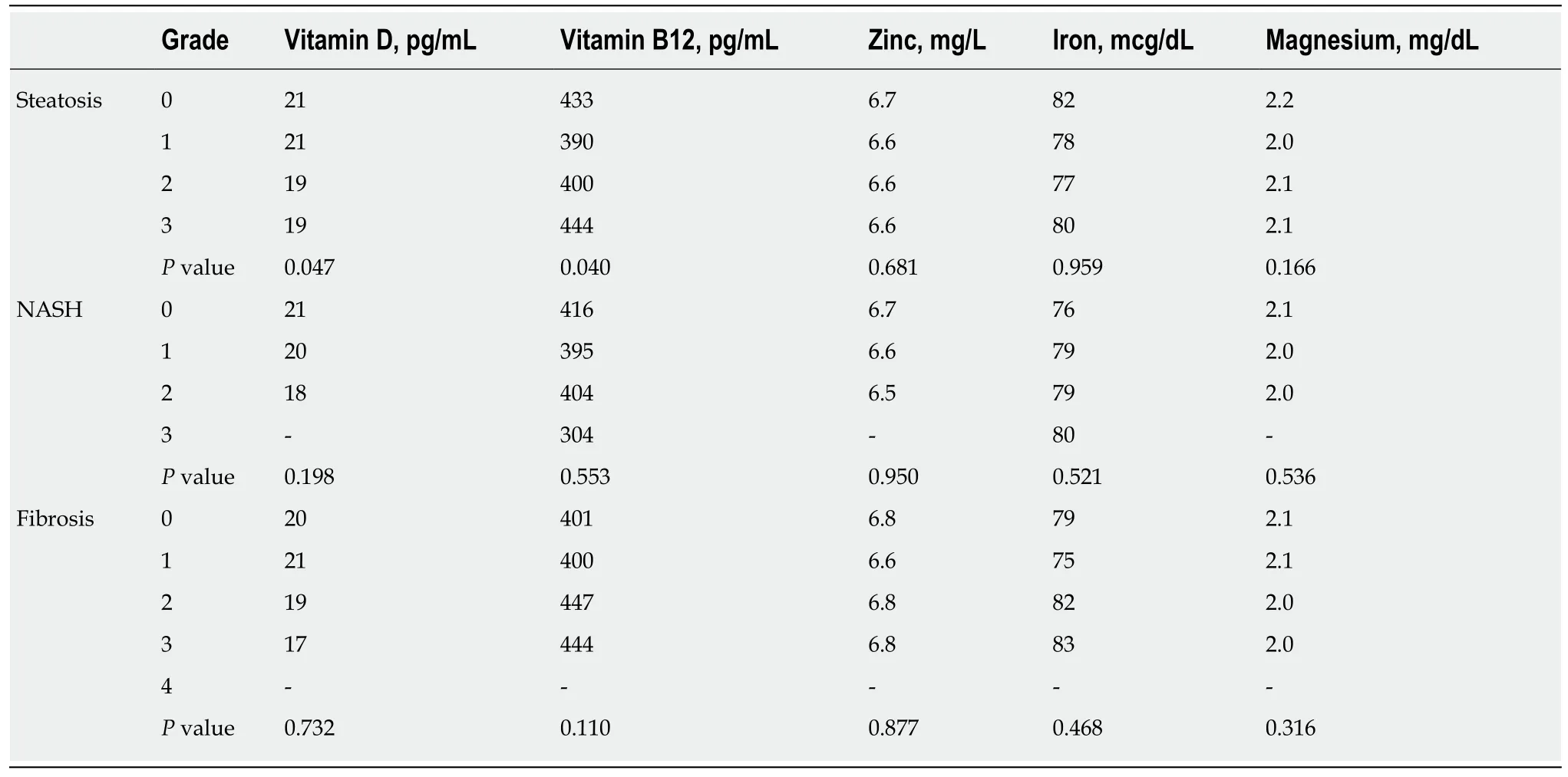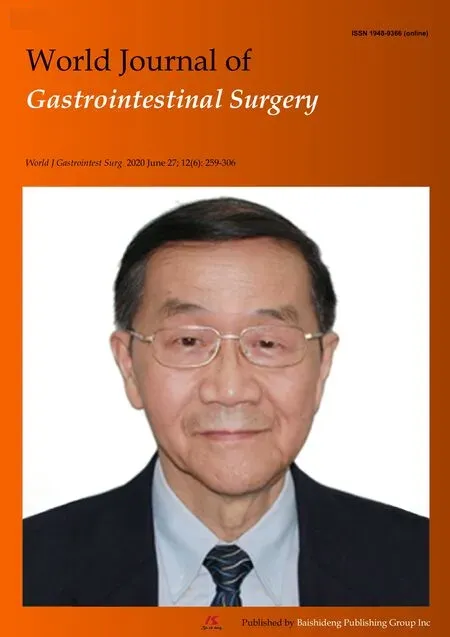Role of micronutrients in staging of nonalcoholic fatty liver disease:A retrospective cross-sectional study
Franciele Sabadin Bertol,Bruna Araujo,Brunno Brochado Jorge,Natalino Rinaldi,Luiz Alberto De Carli,Cristiane Valle Tovo,Graduate Program of Medicine,Hepatology,Universidade Federal de Ciências da Saúde de Porto Alegre,Porto Alegre,RS 90430080,Brazil
Abstract
Key words:Nonalcoholic fatty liver disease;Nonalcoholic steatohepatitis;Liver cirrhosis;Micronutrients;Vitamin D;Vitamin B12;Zinc;Iron;Magnesium
INTRODUCTION
Nonalcoholic fatty liver disease (NAFLD) presents with a high incidence throughout the world,affecting about 20%-25% of the population[1-3].Its prevalence is increasing due to changes in lifestyle and the obesity epidemic;besides,it is believed that by 2020,NAFLD will be the leading cause of chronic liver disease,which will also increase public expenditures worldwide[3,4].
This disease is considered to be a hepatic manifestation of the metabolic syndrome,causing an increase in overall mortality that is mainly related to cardiovascular diseases[5-9].Obesity is the main risk factor for the disease[10].
The pathogenesis of NAFLD is heterogeneous and not yet fully understood,encompassing simple steatosis,nonalcoholic steatohepatitis (NASH),and cirrhosis as consequences.It is of crucial importance to identify the factors that lead to disease progression to find possible therapeutic targets.
Just as excess of macronutrients contributes to tissue damage and alteration of energy homeostasis in NAFLD patients,they may also contribute to disease progression,disrupting lipid homeostasis and antioxidant mechanisms[11].
NAFLD also promotes mineral deficiency[12,13],and thus changes in the metabolism of vitamin D,vitamin B12,zinc,iron,and magnesium may be related to histological and/or clinical events in NAFLD patients.However,studies that evaluate the relationship between micronutrients and NAFLD are scarce,and present controversial results[11,13-17].
The present study aims to analyze the correlation between NAFLD staging and the serum levels of micronutrients (vitamin D,vitamin B12,zinc,iron,and magnesium) in obese patients.
MATERIALS AND METHODS
A retrospective cross-sectional study was developed for patients treated between 2002 and 2016 at the Center for Obesity Treatment of the Hospital Santa Casa de Misericórdia de Porto Alegre,RS,Brazil,a tertiary referral hospital in southern Brazil.
The inclusion criteria were patients who underwent liver biopsy during bariatric surgery and who had measured serum levels of at least one of the micronutrients studied (vitamin D,vitamin B12,zinc,iron,and magnesium) during outpatient evaluation prior to the surgical procedure.
The exclusion criteria were patients with viral hepatitis B or C,HIV,other causes of chronic liver disease,significant alcohol consumption (> 21 doses per week for men and > 14 doses per week),use of potentially steatogenic drugs,or secondary causes of NAFLD[18].
Liver biopsies were analyzed by a professional with experience in liver pathology,according to the criteria of Kleineret al[19].
Clinical and laboratory data were collected during a previous evaluation performed up to 1 year before bariatric surgery.The variables of age,sex,body mass index (BMI),presence of comorbidities [diabetes mellitus (DM),DM complications,systemic arterial hypertension (SAH),sleep apnea,smoking,and dyslipidemia],vitamin D,vitamin B12,zinc,iron,and magnesium were analyzed.
Patients were stratified according to the World Health Organization classification for obesity (Class I:BMI between 30 and 35 kg/m2;Class II:BMI between 35 and 40 kg/m2;Class III:BMI > 40 kg/m2)[20].
All analyses were tabulated and processed using the Statistical Package for the Social Sciences program (PASW Statistics for Windows,Version 18.0.Chicago:SPSS Inc),and the significance level was set at 5%.
Means and standard deviations were described for variables with normal distribution,and medians were described for variables that did not present normal distributions,which was verified by the Kolmogorov-Smirnov test.
The Kruskal-Wallis test was used to correlate the degrees of hepatic steatosis with serum levels of the different micronutrients.The Mann-Whitney test was used to compare the serum levels of micronutrients between patients with mild/absent steatosis,NASH,and fibrosis,as well as those with advanced steatosis,NASH,and fibrosis.
RESULTS
Of the 1752 patients who had performed bariatric surgery during the study period,1138 were excluded because they did not undergo liver biopsy.This study thus included 614 patients.
The mean patient age was 37.2 ± 9.7 years,79% were female,and 83.1% had some comorbidity (17.2% DM,41.7% SAH,14% sleep apnea,77% smoking,and 40.9%dyslipidemia).
When liver histopathology was evaluated,93% of patients had simple steatosis,70.7% had NASH (grade 1 in 48.3%;grade 2 in 21.4%;grade 3 in 1%),and 49.3 % had fibrosis (grade 1 in 37.2%;grade 2 in 5.8%;grade 3 in 6.3%;grade 4 in 0.5%).
According to the preoperative BMI,most patients (77.1%) presented class III obesity.The medians of micronutrient levels (vitamin D,vitamin B12,zinc,iron,and magnesium) were within the normal range.These results are described in Table 1.
Vitamin D values were higher in patients with grade 1 steatosis than in those with grades 2 or 3;and vitamin B12 levels were higher in patients with grade 3 steatosis compared to those with grades 1 or 2 steatosis.There was no statistically significant difference in mean serum levels of micronutrients according to the different grades of NASH or fibrosis (Table 2).
Vitamin D was significantly higher in patients with absent/mild steatosis compared with patients with advanced steatosis;vitamin B12 was higher in patients with advanced fibrosis compared to patients with absent/mild fibrosis (Table 3).
There was a negative correlation between vitamin D levels and the grade of steatosis and NASH,and a positive correlation between vitamin B12 levels and the grade of steatosis and fibrosis (Table 4).
DISCUSSION
It has recently been suggested that some micronutrients would have antioxidant potential and could reduce the accumulation of reactive oxygen species,consequently delaying or preventing the evolution of NAFLD[11,21].
The present study evaluated the serum levels of vitamin D,vitamin B12,zinc,iron,and magnesium,and their relationship with NAFLD staging.Significantly higher serum levels of vitamin D were observed in patients with absent/mild steatosis compared to patients with advanced steatosis;and significantly higher serum levels of vitamin B12 were observed in patients with advanced fibrosis compared to patients with absent/mild fibrosis.There was also a negative correlation between vitamin D and the grade of steatosis and NASH,and a positive correlation between vitamin B12levels and the grade of steatosis and fibrosis.No correlation was found between the staging of NAFLD and serum levels of zinc,iron,and magnesium.

Table1 Sample characteristics
In the literature,studies evaluating the relationship between micronutrients and NAFLD are scarce and controversial.
Vitamin D may affect the development and course of liver diseases,mainly due to its immunomodulatory role[22].It may also inhibit the formation of human type I collagen in stellate cells,suggesting a relationship between vitamin D deficiency and the progression of liver fibrosis[23].In addition,low levels of vitamin D have been associated with the severity of steatosis,NASH,and fibrosis in NAFLD[24,25].Vitamin D deficiency has also been associated with increased insulin resistance and exacerbation of hepatic steatosis in obese rats[26];besides,studies on this subject are scarce and inconclusive.The present study found a higher vitamin D level in patients with absent/mild steatosis compared to patients with advanced steatosis,which is in agreement with most published studies[23-26].
The association between vitamin B12 and NAFLD remains controversial.Someauthors report similar[15,27],higher[28,29],or lower[30]serum levels in NAFLD patients compared to control patients.Vitamin B12 reduction could be associated with insulin resistance and endothelial dysfunction[31].The present study presented a positive correlation between serum levels of vitamin B12 and staging of NAFLD,and patients with advanced fibrosis had higher serum levels of this vitamin.

Table2 Mean serum levels of micronutrients according to liver histopathology staging
Zinc has been implicated in the pathogenesis of liver diseases of various etiologies[17,32].Some studies obtained a good correlation between zinc deficiency and hepatic steatosis in experimental models of hepatic steatosis[12,33].However,there are no studies with human subjects that show a correlation between serum levels of zinc in NAFLD and disease severity.In the presenting study,the serum levels of zinc showed no statistically significant difference between the grades of steatosis,NASH,or fibrosis.
Iron has also been implicated in the pathogenesis of NAFLD,but its role is not yet fully elucidated.The relationship between serum levels of ferritin and staging of NAFLD has been reported;however,ferritin is an inaccurate measure of iron storages[34,35].Ferritin levels 1.5x above the normal range have been independently associated with the grade of fibrosis in patients with NASH[16,36].However,some studies did not corroborate this association[37-40].The present study evaluated the serum levels of iron in patients with NAFLD,which did not correlate with the severity of NASH or fibrosis.
Serum levels of magnesium have been independently associated with the presence of steatosis and NASH compared to healthy individuals[41].Inverse correlations have also been observed between the serum levels of magnesium and glycemic indices in patients with insulin resistance[42].In the present study,however,no statistically significant correlation was found between the serum levels of magnesium and staging of NAFLD.
Although this study found a relationship between the severity of NAFLD and serum levels of vitamin D and vitamin B12,its clinical relevance is questionable,as these are weak correlations.However,possible limitations include the fact that this was a retrospective study,due to the large number of patients analyzed.The importance of the observed data should therefore be considered.
In conclusion,the serum levels of vitamin D are inversely related to steatosis and the severity of NASH,and the serum levels of vitamin B12 are higher in more advanced stages of steatosis and liver fibrosis.Serum levels of zinc,iron,and magnesium are not associated with the severity of NAFLD.

Table3 Serum levels of micronutrients and liver histopathological analysis

Table4 Severity of nonalcoholic fatty liver disease and serum levels of micronutrients
ARTICLE HIGHLIGHTS
Research background
It has been suggested that some micronutrients would have antioxidant potential and could reduce the accumulation of reactive oxygen species,consequently delaying or preventing the evolution of nonalcoholic fatty liver disease (NAFLD).
Research motivation
Identify potential new therapeutic strategies for NAFLD.
Research objectives
Evaluate the relationship between serum levels of micronutrients and the severity of NAFLD.
Research methods
A retrospective,observational,and cross-sectional study was conducted.This study included patients undergoing bariatric surgery at a reference center in southern Brazil.These patients underwent liver biopsy during the procedure and had serum levels of micronutrients assessed in a preoperative evaluation.
Research results
Serum levels of vitamin D were negatively correlated with the severity of steatosis and nonalcoholic steatohepatitis,and serum levels of vitamin B12 were positively correlated with the severity of steatosis and fibrosis.
Research conclusions
Serum levels of vitamin D are inversely related to the severity of steatosis and nonalcoholic steatohepatitis,and serum levels of vitamin B12 are higher in more advanced stages of simple steatosis and liver fibrosis.
Research perspectives
Further studies should be done to assess the relationship of micronutrients and NAFLD.
 World Journal of Gastrointestinal Surgery2020年6期
World Journal of Gastrointestinal Surgery2020年6期
- World Journal of Gastrointestinal Surgery的其它文章
- COVlD-19 outbreak and surgical practice:The rationale for suspending non-urgent surgeries and role of testing modalities
- Efficacy of the fat-dissociation method for nodal harvesting in gastric cancer
- Robotic vs laparoscopic right colectomy - the burden of age and comorbidity in perioperative outcomes:An observational study
- Cystic low-grade collecting duct renal carcinoma with liver compression — A challenging diagnosis and therapy:A case report
